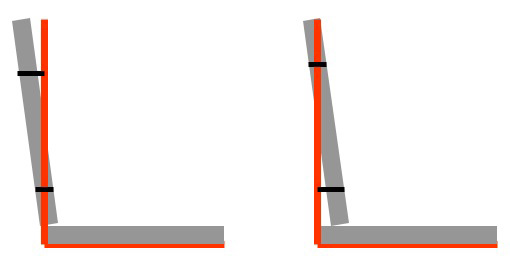Share:
Hello all!
Last month, I wrote about centre of gravity and its application to different types of manual wheelchairs. This month, I would like to address an important consideration related to centre of gravity when prescribing standard wheelchairs.
Recall from last month's article that a folding wheelchair has the ability to alter the forward/rearward placement of the rear wheels, which effects the weight distribution between the front casters and the rear wheels. Optimizing the forward position of the rear wheels helps to reduce the rolling resistance and improve the maneuverability of the wheelchair. Please refer to my previous article, Centre of Gravity and Manual Wheelchairs, found here, if you would like more information on this.
Sometimes, a person may not qualify for funding for a folding wheelchair and we need to consider the seating and wheelchair configuration for a standard wheelchair for that person. Again recall from last month's article that for a standard wheelchair, the rear wheel is in a rearward position relative to the frame. While this position provides for rearward stability, it increases rolling resistance and the strength and effort required to propel a wheelchair. Now it becomes even more important to consider the seating components, specifically the back support, and its possible effect on the weight distribution between the rear wheel and the front caster.
A firm back support is prescribed for many reasons, including positioning, stability, function, skin integrity, and/or increased sitting tolerance. Sometimes we need to angle the back support in order to open the seat to back angle for required positioning. Different back supports come with different types of hardware. Some back supports have hardware that adjusts the angle of the back support through the upper portion of the back canes on the wheelchair. With this, there is little resulting seat depth loss at the maximum available angle. (See the graphic below, to the left. The horizontal red line represents the seat rail and the vertical red line represents the back canes on a wheelchair. The grey lines represent seating. The black lines represent the hardware used with a firm back support.) Other back supports have hardware that adjusts the angle of the back support through the lower portion of the back canes on the wheelchair. (See the graphic below, to the right.) When the hardware adjusts on the lower portion of the back canes of the wheelchair, depending upon the required angle of the back support, seat depth is lost. Of course, we accommodate for this by ordering a wheelchair and cushion with a longer seat depth so that the femurs are properly supported, but we need to consider how positioning the person more forward in the wheelchair, relative to the back canes, effects the weight distribution between the casters and rear wheels.

Now, if a person is positioned more forward of the back canes because the angle of the back support results in loss of seat depth, there is decreased loading through the rear wheels and increased loading through the front casters. This increases the resistance to rolling, which makes the wheelchair more difficult to propel. The chair also becomes more difficult to maneuver. Not only does the loading on the casters contribute to increased difficulty maneuvering the wheelchair, but also the increased overall length of the wheelchair (as a result of accommodating lost seat depth) increases the turning radius, resulting in less maneuverability of the wheelchair.
In terms of the person propelling the wheelchair, some unintended consequences can result. If the person foot propels, he or she may tend to slide forward in the wheelchair as the increased effort required for the heel strike and pull through cause the pelvis to slide forward. (Recall from my series on Prevention of Sliding in Seated Mobility that this is only one factor that may contribute to sliding in a wheelchair.) For a person that hand propels, greater force will be required for each stroke and the number of strokes required to propel the wheelchair increase as the efficiency of propulsion is decreased. Because the rear wheels are even further back for the user if seat depth is lost on a standard wheelchair, the shoulders are in excessive extension when reaching to initiate the stroke, putting the person at risk for upper extremity injury. If there are limitations in range of motion of the shoulder, the contact on the push rim and the push phase of the stroke will be compromised, reducing the efficiency of propulsion.
In summary, when we are prescribing a standard wheelchair for an individual client, understanding the impact of choice of back support and accompanying hardware and the positioning of the person relative to the rear wheels and front casters becomes an important consideration for a person who self propels, whether through the upper extremities, the lower extremities or a combination of the two.